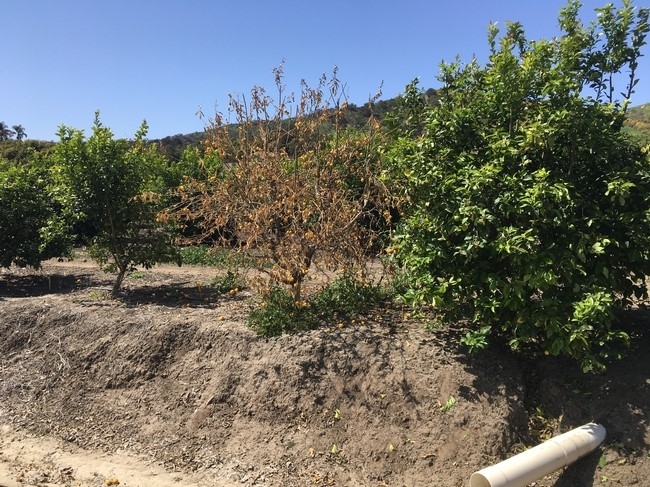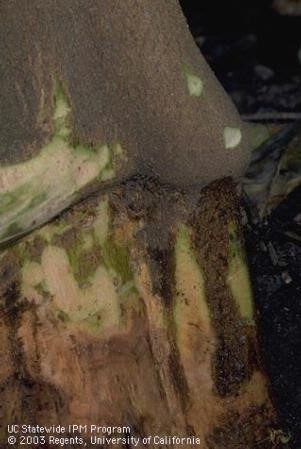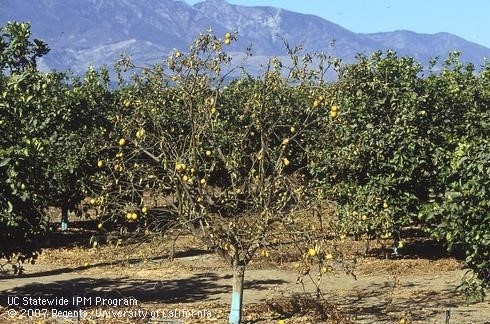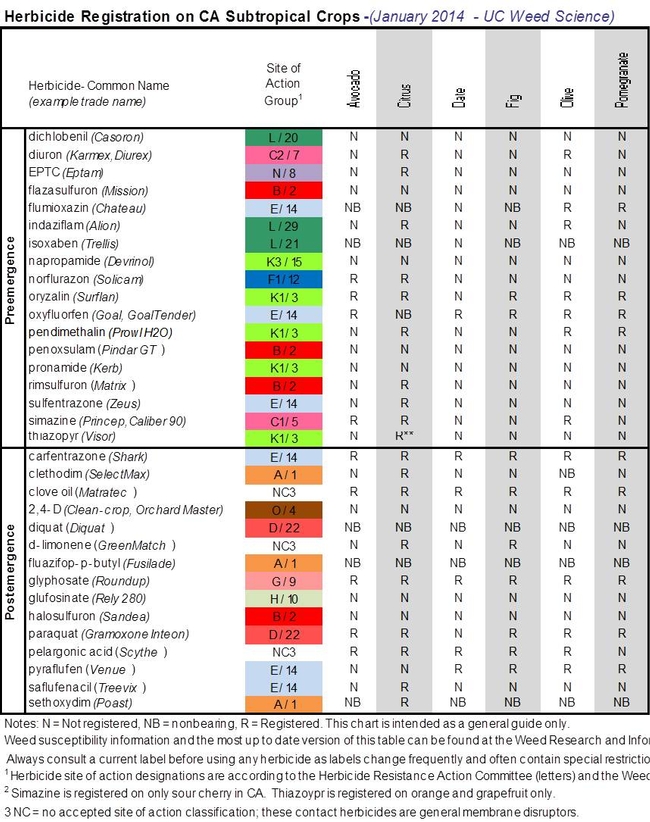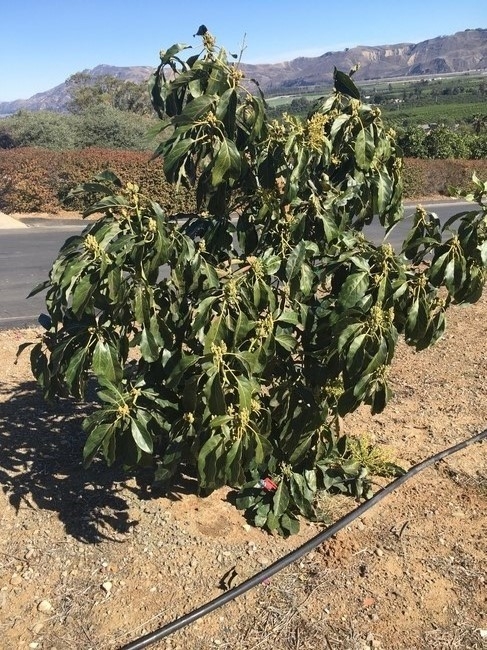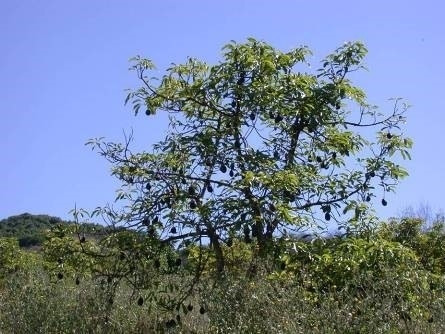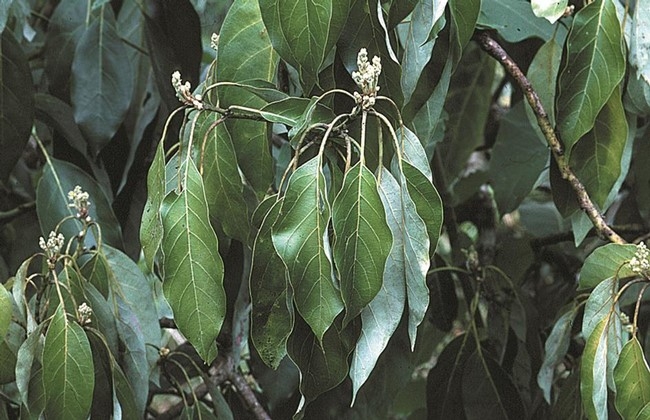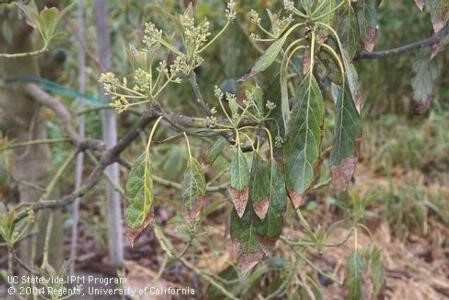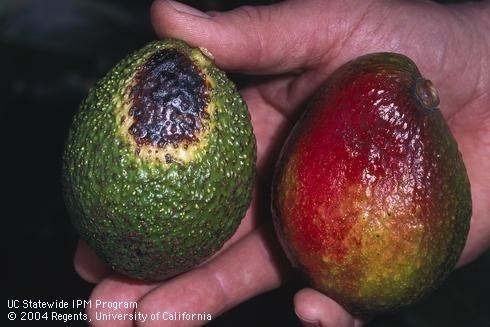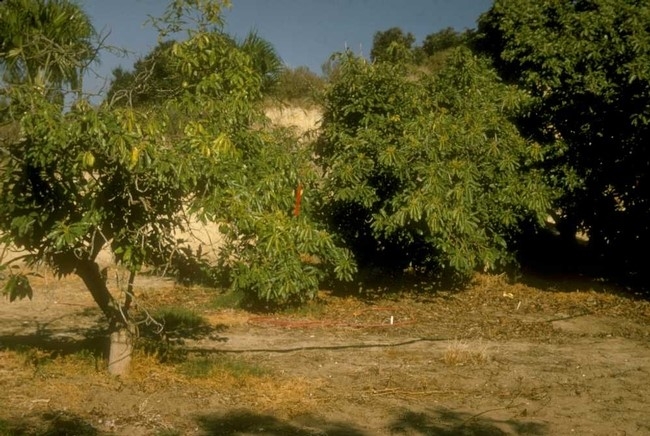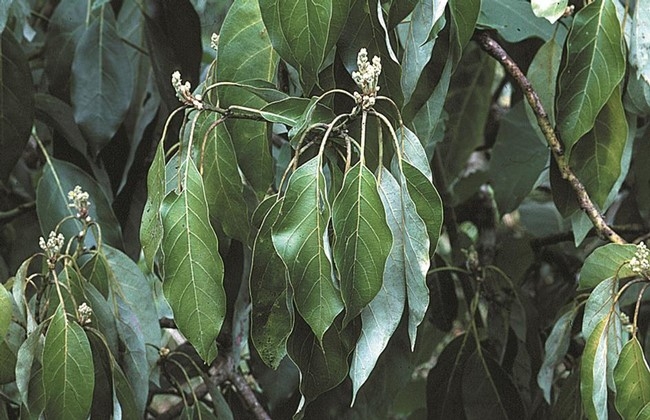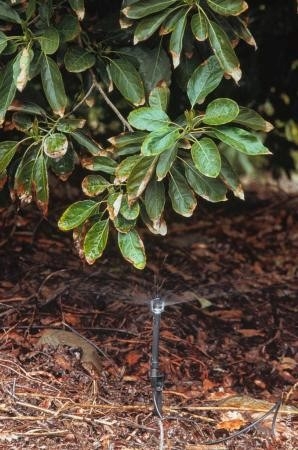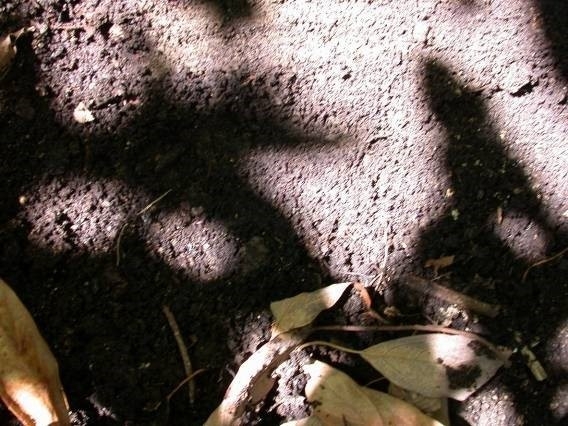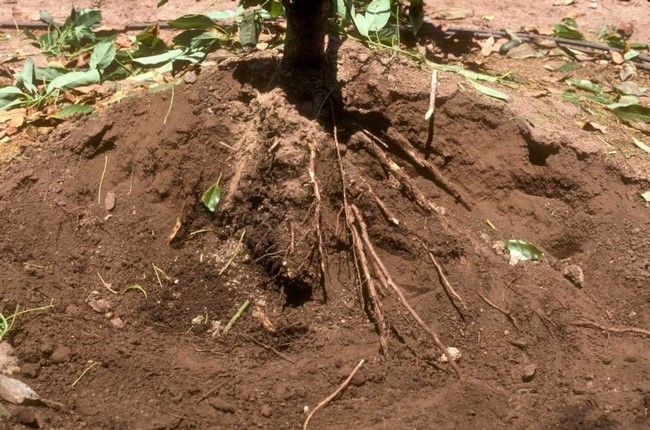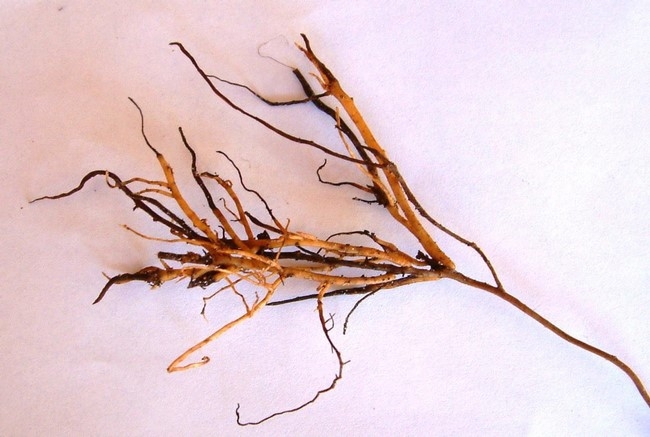
Posts Tagged: root rot
It's Not the Right Time
The calls have come in. Citrus Dry Root Rot has struck. It's not supposed to happen this time of year. We've gone from this beautiful, rainy December to a mild winter mid-80s on some days. But, we had a fierce Santa Ana mid-January that knocked down street trees and caused other damage. And that's the cause. The devil wind. It's shocking how fast the citrus trees go from green to a lifeless brown.
BOOM!
The parting words of my predecessor Nick Sakovich (happily living in Hawaii) were: DRR hits trees between 1-15 years of age, less-well managed trees, trees that have been injured (gophers, weed whips, discing, fertilizer burn, etc.), in the presence of the Fusarium fungus, and it always happens on the first hot day of spring. A nice mild, or even cool winter, and then there is a sudden water demand by the tree on a hot day and BOOM, the tree's leaves turn brown in a weekend.
Dry Root Rot has menaced growers in Ventura County for many years. In the ‘50's and ‘60's it seemed most prevalent on older orange trees. A few years after the wet winter of 1968-69, dry root rot became an increasing problem among citrus trees of all ages. At that time, most of the damaged trees were on sweet rootstock (susceptible to Phytophthora), and growing in fine-textured soils or soils with poor drainage. A few years after another wet winter/spring (of 1983), dry root rot again reared its ugly head, but this time predominately on young lemons.
The disease is caused by the fungus, Fusarium solani. Fusarium in citrus clogs the xylem which carries water to the leaves. When damage is done to the xylem, the ability to carry water is reduced. When a lot of damage is done, that's when you get that BOOM.
The damage occurs at the base of the trunk. The bark has been cut away to show the affected wood beneath
This fungus is most likely present in all citrus soils in California. It is a weak pathogen in that by itself it will not attack a healthy tree. However, experiments conducted in the early 1980's by Dr. Gary Bender, showed that when seedlings were girdled, root invasion occurred. In the field, the fungus can infect trees once gophers have girdled the roots or crown. A Phytophthora infection will also predispose trees to Fusarium, as will asphyxiation. Therefore, the mere presence of the fungus in the orchard soil will not lead to the disease.
So we call it a disease, but it's really a complex of circumstances that need to be present. It has to be a wound, Fusarium and the weather. We forget that wind is a greater drain on a tree's water needs than heat is actually. Same for humans, you got out on a windy day, and you come home and the first thing you do is drink some water. That's the way food is freeze-dried.
And that's the stress we had this year, and BOOM!
There's not a whole lot that can be done after this happens. The way it is managed is through avoiding wounds and making sure that when stressful conditions of wind and heat are forecast, that the tree is well supplied with water.
Nick was mainly right. Dry Root Rot mainly happens with the first hot day of spring, but it can happen anytime a wounded, infected tree goes under water stress. And it can happen to older trees, too.
There's more to this story. Read more about this infuriating disease complex at the UC Integrated Pest Management website - https://www2.ipm.ucanr.edu/agriculture/citrus/Dry-Root-Rot/
And listen to Dr. Akif Eskalen's Dry Root Rot story at "What Are the UC Ag Experts Talking About?"
https://www.youtube.com/watch?v=K2fyBcC1HXk
Citrus Dry Root Rot
Nick Sakovich, Emeritus Farm Advisor
Dry Root Rot has menaced growers in Ventura County for many years. In the ‘50's and ‘60's it seemed most prevalent on older orange trees. A few years after the wet winter of 1968-69, dry root rot became an increasing problem among citrus trees of all ages. At that time, most of the damaged trees were on sweet rootstock (susceptible to Phytophthora), and growing in fine-textured soils or soils with poor drainage. A few years after another wet winter/spring (of 1983), dry root rot again reared its ugly head, but this time predominately on young lemons.
The disease is caused by the fungus, Fusarium solani. This fungus is most likely present in all citrus soils in California. It is a weak pathogen in that by itself it will not attack a healthy tree. However, experiments conducted in the early 1980's by Dr. Gary Bender, showed that when seedlings were girdled, root invasion occurred. In the field, the fungus can infect trees once gophers have girdled the roots or crown. A Phytophthora infection will also predispose trees to Fusarium, as will asphyxiation. Therefore, the mere presence of the fungus in the orchard soil will not lead to the disease.
Description
Fusarium is a soil borne fungus that invades the root system. Once infected, the entire root will turn reddish-purple to grayish-black. This is in contrast to a Phytophthora infection which, in many cases, will attack only the feeder roots, but when larger roots are infected, only the inner bark is decayed and it does not discolor the wood. In addition, when observing the cross section of a dry root rot infected trunk, a grayishbrown discoloration in the wood tissue can be observed.
Dry root rot is a root disease, but symptoms of the root decline are seen above ground. They are similar to any of the root and crown disorders such as Phytophthora root rot, oak root rot fungus (Armillaria) and gophers. The trees lack vigor, leaves begin to turn yellow and eventually drop (especially in hot weather) causing twig dieback. Finally, the foliage will become so sparse that one will be able to see through the canopy of the tree. A period of two to three years may pass from the time of invasion until noticeable wilt. Many times, the tree will collapse in the summer, after a period of prolonged heat. In the case of dry root rot, the collapse is so rapid that the tree dies with all the leaves still on the tree. When looking for symptoms of dry root rot, keep an eye out for symptoms of other maladies as well — Phytophthora, oak root rot fungus and gophers being the most prevalent.
As mentioned previously, in order for Fusarium to infect a tree, there must be a predisposing factor such as girdling from gopher feeding. However, since many trees collapse from dry root rot without any apparent predisposing factor, there are obviously other factors which we have yet to identify. Therefore, in 1998, a grower survey was developed, along with intensive soil and leaf sampling, to attempt to identify as many new predisposing factors as possible. They might be elements in the soil, either deficiencies or excesses, or specific cultural practices such as irrigation patterns or fertilizer practices. Twenty orchards were identified from which 20 soil and 20 leaf samples were taken in diseased areas and another 20 soil and 20 leaf samples were taken from adjacent healthy areas. The owners or managers of the properties were given a questionnaire to complete regarding a variety of cultural operations. The objective was to identify those factors that would correlate well to trees becoming infected with dry root rot.
Survey Results
Soil analysis - The following laboratory procedures were conducted to see if there was any correlation between the disease and either deficiencies or toxicities of these elements or
conditions: sodium, boron, salt level, pH and soil type (sand, loam, clay). For these elements or conditions, no correlation was found. It would appear that for our sampling sites, these conditions, whether favorable or not (toxic or deficient), did not play a major role in predisposing the tree to dry root rot.
Leaf analysis - The following elements were analyzed for their concentration within the leaf: nitrogen, potassium, phosphate, manganese, magnesium and zinc. Of these, three correlations were found. Zinc and manganese levels were substantially higher in diseased trees. The third correlation showed a potassium deficiency in diseased trees. However, we do not believe that dry root rot is caused by elevated levels of zinc or manganese, or by potassium deficiency, but rather are a result of the disease. Unfortunately, it seems that we have still not identified any elements in leaf analysis that truly correlates and points to a predisposing factor for disease development.
Grower survey - The grower survey included questions on planting site (location, wind, previous crop, fumigation etc.), trees (source, type, rootstock, etc.), and cultural practices (irrigation, fertilization, gophers, history of Phytophthora, water quality, etc). Through statistical analysis it was found that the healthy and diseased sites were significantly different with reference to three conditions or situations: 1.) The presence of Phytophthora in an orchard will increase the chance of those trees succumbing to dry root rot. 2.) Orchards that have been fumigated have a less likely chance of succumbing to dry root rot. 3.) Balled vs. Container Plants -- growers were asked if their trees were balled or container
grown nursery plants. Healthy sites were significantly more likely to have been planted with balled trees (73% vs 33%). The results of this analysis were not strong, but rather they
suggest that there is a relationship between the disease and the type of tree planted - balled or container grown - and suggesting in favor of a balled tree for a healthy orchard.
Control Measures – What Works and What Does Not
Early experiments conducted by Menge, Ohr and Sakovich showed that the following circumstances or operations do not influence the incidence of this disease: fungicidal treatments, wounding the tap root at time of planting, sandy versus clay textured soils, spring versus fall planting and soil mounding.
- In choosing your nursery tree, the choice of rootstock is not important in that, as far as we know, all rootstocks are susceptible to this disease. However, since Phytophthora is a major component in dry root rot development, choosing a rootstock like sweet orange would certainly put those trees in a high risk category. We recommend that growers use Phytophthora resistant rootstocks like C35 or Citrumelo.
- According to the survey, it would be advantageous to fumigate before planting. Methyl bromide, although expensive, is the best fumigant as it is a complete biocide. If one chooses not to fumigate, the alternative would be a number of fungicide/nematicide applications to the newly planted trees. Generally speaking, this may work well with trees planted on a rootstock like Citrumelo or C35.
Phytophthora. Publications written in the 1970's, and again noted by our survey, showed that Phytophthora is a major culprit in the dry root rot complex. To control dry root rot, it is essential that the Phytophthora, when present, be controlled. This can be accomplished by fungicidal treatments, and by the proper application and timing of irrigation water. Overwatering creates a favorable environment for the multiplication of the Phytophthora fungus.
Gophers. It is well known that gopher damage provides entry points for Fusarium. Controlling gophers is an important factor in reducing the potential of infection by Fusarium.
Control
We presently have no direct control for dry root rot. To control the disease, we must control the predisposing factors such as gophers, Phytophthora, poor drainage and over-watering. If the predisposing factor(s) cannot be identified for a given diseased orchard, it will indeed be difficult to control the disease. Two things are certain though: 1.) There are no chemicals to date which will control this disease; and 2.) Presently, there are no rootstocks resistant to the disease.
Hear the latest on DRR with Akif Eskalen – a Webinar, July 24
https://ucanr.edu/blogs/blogcore/postdetail.cfm?postnum=30658

citrus dry root rot
Here Comes Citrus Dry Root Rot
Citrus Dry Root Rot
This impressive tree collapse is most noticeable after rainy season and the first heat waves after the rains
Citrus Dry Root Rot (July 24, 2019 from 3-4 pm)
Dr. Akif Eskalen, Plant Pathologist, UC Cooperative Extension Specialist, will discuss the symptoms, biology and management of citrus dry root rot. More information to come. One DPR CE unit (other) and one CCA CE unit (IPM) are pending.
Register in advance for the webinars by clicking on the event links above.
And if you missed it
Recording of the Management of Weeds in Citrus Orchards webinar is now available on YouTube - https://youtu.be/DU5bpRnq8DI
Dr. Travis Bean, assistant weed science specialist in UCCE, discussed the importance of weed management in citrus, tree age and variety considerations, scouting and weed identification, cultural and mechanical practices, and pre- and post-emergence herbicides.
Upcoming topics:
- Spray technology for tree crops (August)
- California Red Scale (September)
- Avocado diseases II. (October)
- Use of Plant Growth Regulators in Avocado (December)
Register in advance for the webinars by clicking on the event links above.
Are there Continuing Education units?
When the subject discusses pest or disease management, continuing education units will be requested from DPR (1 unit per session). Participants will pre-register, participate in the webinar and be awarded the unit. The sessions will be recorded and hosted on this web site for future study. However, continuing education units will be awarded only to the participants who attend the live version of the webinar.
Who is involved?
This webinar series is brought to you by Ben Faber (UC ANR Ventura Advisor) and Dr. Beth Grafton-Cardwell (Depart of Entomology UC Riverside Extension Specialist) with the technical support of Petr Kosina (UC IPM Contect Development Supervisor) and Cheryl Reynolds (UC IPM Interactive Learning Developer).
The Skinny on Avocado Pests and Diseases
Anthracnose, Sunblotch, and Armillaria Root Rot
Avocado Trunk Canker and Collar Rot
Avocado Branch Canker (Botryosphaeria)
Phytophthora Root Rot of Avocado and Management Strategies
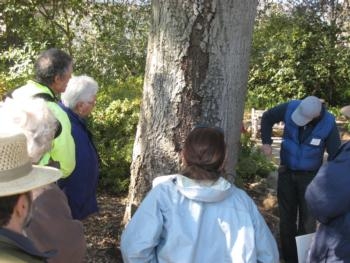
field id
Drought or Root Rot? - 12 Steps
We recently had a series of workshops on Avocado Root Rot and ways to manage it. A common question was how to figure out whether the tree was diseased with Phytophthora cinnamomi or just stressed from lack of water. Drought is also compounded and confused by salt accumulation, which is a reflection of how water is being managed. It might be the right amount, but not timed correctly. Too much at one time means the water goes beyond the shallow root system, too little at an irrigation and the salts contained in the water start being taken up by the roots. These “extra” salts need to be leached; otherwise, they actually compete with the tree for soil water. By “extra”, these are the salts like sodium and chloride that can be harmful to the tree, rather than the nutrient salts that are necessary for tree growth, but will also be leached when trying to achieve a balance by removing the harmful salts.
So there are several steps to follow to figure out a droughted tree from a root rotted tree. If the tree is stressed from drought, eventually though, it quite likely can lead to root rot. Looking at wilted leaves is an indication of a stressed root system which is common with a lack of water, but can happen when the roots are soaked for too long from rain, a leaky irrigation system or sediment accumulation that can occur with flooding. Wilting is also one of the first symptoms of root rot, because there are not sufficient roots to keep up with the tree's water demand.
Step I. Wilting
Wilting is going to be the first step in alerting you to a soil/root/water problem, but it is just the first alert and there are more steps to a field diagnosis. The steps take on three different parts of the tree:
First, look at the canopy overall and then more closely in the canopy
Then, look AT the ground
Then, look IN the ground
If you look at the tree from a distance and the canopy is thinning with dieback (staghorning)
Step 2: Thinning canopy.
This means that it is something that has been going on for a longer time that just to cause the leaves to flag (wilt)
And when you look more closely, the leaves are small, yellow, have tip burn and there are lots of flowers
Steps 3, 4, 5: Small, yellow leaves; tip burn; profuse flowering
This again means that it's something that just didn't happen with a missed irrigation or two, or a stopped up emitter. Something has been going on for maybe more than a season.
And if there is fruit, if it is sunburned which means it probably isn't saleable, it means there isn't enough canopy to protect income
Step 6: Small, sunburned fruit
Now you definitely know there is a problem with the roots. The roots mirror the canopy. When they go wrong, they canopy goes wrong. All these thinning symptoms in the canopy, also means the root system is thinning. Also, when the canopy goes wrong, the roots have problems. When the canopy can't feed the root system it is less able to fend off disease, if that is the cause of the thinning canopy problem. At this point, it's not definitive that it is root rot causing the problem, but a sad canopy can lead eventually to a root rot problem because of lack of energy generated in the canopy.
The next step is to look AT the ground surface and see if there's natural leaf mulch. If the tree lacks energy to produce leaves, there won't be any leaf drop and now leaf accumulation. These should be leaves in various stages of brown, indicating they have been there for a while. This mulch protects the roots from drying out and also produces an environment hostile to the root rot organism. No leaves to feed the fungi and bacteria that compete and destroy Phytophthora, eventually Phytophthora will come to dominate the system. No energy to produce leaves; no canopy to protect leaf mulch from wind? And, then the wind blows the leaves away. On hillsides, gravity can act against mulch creation and also exposes trees to more wind, but a healthy tree can create its own mulch in harsh hillside environments.
Step 7: No natural leaf mulch
With a sick canopy and no natural leaf mulch, this is the time to think there is something seriously wrong. There is something wrong with the water uptake in this tree. Either a lack of water or a lack of roots. Is it the timing, amount or distribution of the water? These are all issues that can be corrected if there is sufficient water to do so. Maybe the soil is too wet? It could be asphyxiation. Lack of air. That can be corrected by identifying the cause of the lack of air or too much water.
Step 8: Asphyxiation
But if the soil is not too wet, when you apply water, does the tree perk up? Give it a couple of days. This could always have been the problem. Does the water come on? Is a valve shut down? Is the system not working? Is there poor water distribution. This infrastructure problem is common in hillsides irrigation with cheap parts that are easily damaged by coyotes, rabbits, and pickers.
Step 9: Turn on the water
But if the tree does not or has not responded to applied water, then start digging. It's time to look IN the ground. This is something that should be done on a regular basis just to see how those roots are doing, anyway.
And when you start digging, there's no roots
Step 10: NO roots
Or only big roots
Step 11: Only big roots
And, if you do find any little roots, they are blackened and brittle
Step 12: dead root tips
And you have applied water and the tree doesn't perk up, then the tree probably has Avocado Root Rot disease caused by Phytophthora cinnamomi.
There can be other reasons, for a tree collapse like this, like a gas pipe leak, gopher activity in young trees, a chemical/fertilizer spill. Probably other things that kill roots, but a field diagnosis like this process can pretty much identify the problem as root rot. It can then be verified by a lab test to make sure. However, there are times of the year and disease conditions when a test will come back negative and it might be necessary to retest with another sample at another time of year.
Most groves that have been in the ground for many years and have been harvested by outside commercial crews quite likely have the root rot organism present in the orchard. The lack of disease is because the stress that brings on disease is lacking – water management, frost/heat damage, flooding, too much rain, too much fruit, pruning, etc. – anything that predisposes the tree to infection. It is when several stresses are present that the trees start declining and if identified soon enough can be corrected and the decline stopped and reversed.

